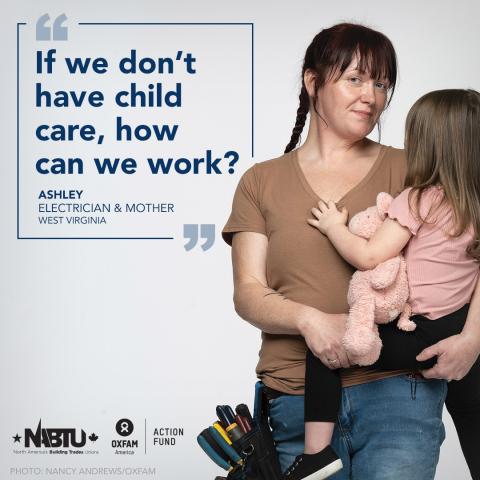
Nancy Andrews/Oxfam
Ad Campaign: Child Care is Part of America’s Infrastructure
By: Alejandra Londono Gomez and Christian Collins
Last November, Congress passed the $1.2 trillion Infrastructure Investment and Jobs Act. While the funding is dedicated to much-needed physical infrastructure projects, Congress has failed to support the child care needs of men and women who are needed to do the work.
In conjunction with Oxfam, the North America's Building Trades Unions, Service Employees International Union, and National Women's Law Center, the Center for Law and Social Policy helped develop an ad campaign to bring awareness to this issue. Ashley, an electrician from West Virginia and mother of seven, was interviewed for the campaign. She’s part of the crew building a high school that was damaged in a flood a few years ago. Ashley had a simple message, “if we want those things to get done in a timely manner, those parents have to be able to work, too.” She also shared a sentiment that resonates with all parents, “If we don’t have child care, how can we work?” Our nation can’t meet the goal of this congressional investment if we neglect child care support for working parents.
Child care is vital as one-third of the U.S. workforce, or 50 million workers, have a child under 14 years old in their household. A 2018 survey of construction apprentices found that 45 percent of mothers and 26 percent of fathers identified the cost of child care as a problem. Ashley knows firsthand how unaffordable child care is. As a parent who needs afterschool care for four children and fulltime care for one child, she shared that “it is pricey...It gets extreme.” Parents, especially those with low incomes and parents of color, have historically struggled to afford child care for their children. Families who make less than poverty-level earnings spend approximately 30 percent of their income on child care, much more than the federal affordability benchmark of 7 percent.
Even if parents are able to secure assistance to help cover child care expenses, they are finding it increasingly difficult to locate services that work for their families. This chronic shortage of child care has intensified by the pandemic-induced health and economic crisis. Parents like Ashley, who need to leave their house early to get to their construction sites, struggle to find child care centers that open before 6 a.m. When speaking about her youngest daughter, Ashley shared, “we actually don’t have a child care option because there is nothing that opens early enough for me to take her.” Ashley is currently relying on a family member to help care for her youngest. She mentioned that after this school year, she has “to get her in a daycare because I won’t have a family member that’s able to watch her anymore. So, it’s a real issue.”
Child care shortages are not going away without significant investment in the system. The devaluation of the child care and early education profession, coupled with a racist legacy that has further marginalized care providers, and has perpetuated low wages and poor conditions for child care workers. The price providers charge for care often doesn’t meet the costs to provide high-quality care for children, but parents simply can’t afford to pay more. The combination of low wages for providers, the lack of public investment, and the already high costs falling to parents has created a crisis that the U.S. Treasury Department calls a “market failure” and “unworkable.”
Vikki, a child care worker in West Virginia for the last 26 years, shared that she makes $12.70 an hour, which is slightly lower than the 2021 median national pay of $13.22 for child care workers. She added, “they can’t hire anybody because you can go to McDonalds and start at $10-11 an hour. Hobby Lobby I think pays $15 an hour. There’re some great people that we’ve lost because of that. One of my teacher’s aides left. I just lost my bus driver. We need funding, especially for wages so we can get people who are qualified.” Low wages and minimal benefits for providers are not just a West Virginia problem, they are common all over the country. This dismal compensation is also fueling a growing movement of care workers organizing for federal investments in child care and for union contracts for child care workers to ensure any additional funding intended to improve wages actually makes it into workers’ paychecks.
Federal investments in the child care industry are crucial to creating an equitable system so parents can go to work and know their children are safe and well cared for. Construction workers, as well as other laborers around the country, are paving the way to a better future and it is time that our policies reflect that by supporting their hard work. Similarly, early educators who face equally shameful economic treatment deserve to be recognized and appreciated for the vital role they play in taking care of our future generations.
Ashley closed by saying, “I don’t like to be the person that doesn’t show up.” Now it’s time for Congress to show up for her and for all the other parents and providers who are READY for change by passing legislation that invests in the child care infrastructure.


The views and opinions expressed in this post are those of the author(s) and do not necessarily reflect those of MomsRising.org.
MomsRising.org strongly encourages our readers to post comments in response to blog posts. We value diversity of opinions and perspectives. Our goals for this space are to be educational, thought-provoking, and respectful. So we actively moderate comments and we reserve the right to edit or remove comments that undermine these goals. Thanks!